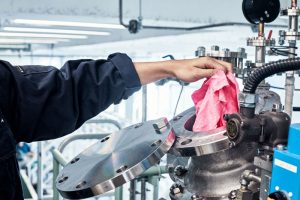BURSA, Turkey — November 2, 2021 — Back in June, ISKO and Soorty announced the signing of a landmark technology licensing agreement which sees the two companies working in partnership on the production of fabric and garment collections. Today, the two companies have announced the launch of their first collaborative effort – ISKO Future Face™ by Soorty collection.
Created using ISKO’s innovative ISKO Future Face™ technology, the collection is produced by Soorty specifically for the US market. The ISKO Future Face™ technology is a patented woven fabric that looks like a knit: it combines a soft, silky finish with comfort, enhanced shape retention and a flattering drape, while maintaining all the properties of true denim. ISKO Future Face™ by Soorty is washed using the most responsible laundry techniques that avoid the use of stones, PPE or hazardous chemicals while reducing the water, energy and resource need, a collection that will help consumers to take care of the planet while staying stylish and comfortable.
As people emerge from isolation after a year and a half, it’s clear that everyone has been changed by the pandemic. Clothing is yet another reminder of this unintended yet undeniable transformation. Designing a life between masks, remote working, going out and meeting with nature whenever possible has brought back the sense of wellbeing to city lives. While defining a new normal, there shouldn’t be a choice between city life and comfort and both can be mutually inclusive. This is the age of a global awakening, abandoning the norm and embracing change which is necessary for a transition towards a brighter future for the industry.
Being truly at the forefront of sustainability, inclusivity, technology and education, both brands are always evolving and launching different initiatives that focus on a change for the better for the industry. Examples include Soorty approaching DENIM AS A POWER OF GOOD with a continuous investment on latest technology smart machinery and innovations that use less of what is limited and make more of it as well numerous CSR projects they conduct focusing on equality and welfare of all, creating an inclusive workplace, creating a transparent education platform, introducing the one size fits all – adaptive denim technology with genderless and unisex fabrics to open room for inclusivity, diversity and responsibility .
As for ISKO, the leading denim ingredient brand is continuously advancing circularity in fashion through new partnerships and activities, as well as contributing its expertise in textile innovation. A case in point is its recently announced participation in The Jeans Redesign, a project established by the Ellen MacArthur Foundation’s Make Fashion Circular initiative, and the commitment that 85% of ISKO’s entire fabric production will consist of recycled material content made from pre-consumer and post-consumer recycled materials – a production that will be independently verified by Textile Exchange audit bodies. It has also provided scholarships to underprivileged students through the Sani Konukoğlu foundation.
For the ISKO Future Face™ by Soorty campaign, no editing or photoshop was used on the imagery of the models. This is the brands’ next continuation on the inclusivity movement, accepting different bodies, embracing everyone, and staying true to oneself without falling for the image that society portrays. This complements going back to the city after the pandemic and provides a reconnection moment which is the main story of the collection.
The collaboration between the two powerhouses combines ISKO’s renowned expertise in creating best-in-class, patented technologies with Soorty’s extensive vertical production network, which will be utilized to produce the collections; it also taps into a true passion for fashion solutions that never sacrifice looking good while upping their responsibility and sustainability game. This unique collaboration opens the door to significant, new business opportunities for both companies and will enable them to meet customers’ needs on a greater scale.
Through this partnership, ISKO and Soorty have developed a business model that is a first in the industry with the potential to change working practices for the better and unlock value for the entire market through the scaling of responsible innovations. The two players are driven by a shared approach that prioritizes synergy, cross-fertilization, and a quest for constant improvement.
Today’s business landscape is calling out to all stakeholders to create connections that help take care of the planet and its people. ISKO’s Responsible Innovation™ approach is founded on creativity, competence and citizenship and demonstrates the company’s effort to make the world a better place. Soorty, Pakistan’s largest vertically integrated denim company, is committed to a vision of a clean, green and fair future for all, which is a perfect alignment for this partnership.
“We have always aimed at pioneering new models and innovations for the industry, like patenting textile technologies and building an actual denim ingredient brand”, said Marco Lucietti, ISKO Director of Strategic Projects. “We are now proud to be the ones to initiate this kind of new collaboration together with Soorty.”
“ISKO Future Face™ by Soorty is a truly game changing offer that can be used to create an endless array of products, all of which are in high demand in both the pandemic and post-pandemic world. We’re hugely excited by the possibilities this opens up for the market”, said Asad Soorty, Director of Soorty Enterprises.
Posted November 2, 2021
Source: ISKO






